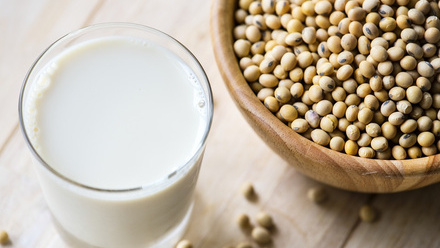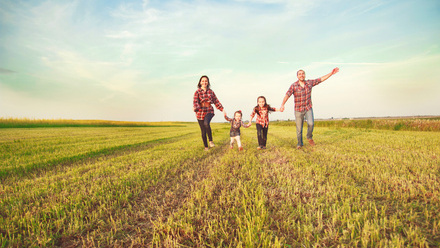Linia Patel on how diet, lifestyle and age have a bearing on bone health.
Every three seconds there is an osteoporosis fracture in the world.
Worldwide, that makes fractures from osteoporosis more common than heart attacks, strokes and breast cancer combined. Osteoporosis is linked with weak bones and is dubbed the ‘silent thief’ as you don’t feel the damage while it proceeds. Many adults will not be aware they have porous bones until they happen to fall.
Falls that result in a fracture to your bones impact your quality of life massively and, if you’re an older person, your chance of dying shortly afterwards skyrockets. Strong and healthy bones are vital to good health and good nutrition is crucial to strong bones.
Bone physiology 101
Physiologically, bones are not just walls of calcium. Much of your bone structure is a matrix of minerals with protein, connective tissues and a network of nerves and blood vessels with the marrow at the centre. Bone density is a measure of the amount of calcium and other minerals found in your bones. Both osteopenia (low bone mass) and osteoporosis (brittle bones) are conditions characterised by low bone density. Worldwide, one in three women over the age of 50 will experience osteoporosis fractures, as will one in five men aged over 50.
Populations at risk of poor bone health
There are some groups who are at risk of having poor bone density. These include people who have cut out dairy from their diets, those who follow excessive and extreme diets that don’t provide enough total energy, and post-menopausal women.
Chronic and extreme dieters
First and foremost, strong bones need enough energy coming in. Extreme diets and aggressive weight loss will increase your risk of getting in the red zone. The technical term for this is relative energy deficiency syndrome (RED-S). Not getting enough energy sets off a negative hormonal cascade which has an impact on bone mass. This is why disordered eating has a long-lasting negative influence on bone health.
Dairy-free diets
You can eat plenty of calcium, but it is important to consider its bioavailability. There are nutrients called phytates and oxalates found in foods, which bind up minerals and prevent us from extracting them. Phytates are found in grains, seeds and nuts, and oxalates are found in spinach, sweet potatoes and rhubarb, for example. This means that foods like spinach (which contains calcium) are not necessarily good sources of calcium. If you are vegan, for example, you need to be conscious of your calcium intake to ensure that you consume enough that are bioavailable to you. Great choices are tofu, sesame seeds, pak choi, kale and beans.
Menopausal and post-menopausal women
Around 10% of a woman’s bone mass is lost in the first five years of the menopause, and this increases your risk of osteoporosis – a condition where your bones are more likely to break. After the menopause, women are more likely to be affected by osteoporosis. This is because oestrogen helps to keep your bones strong and healthy. Less oestrogen puts you at risk of developing osteoporosis. Muscles and bones are also intricately linked, and lower testosterone and oestrogen levels put women in the menopause transition at an increased risk of losing muscle mass.
Good nutrition, good remodelling of bones
About every 10 years, you end up with a completely new skeleton. This is because bones may look hard and static, but they are living and dynamic tissues. They are constantly breaking down and remodelling themselves. Nutrition is vital for healthy bones. Good nutrition supports bone mineralisation and helps the whole skeletal complex stay healthy as well. From a nutrition point of view, these are the factors you need to get right.
Protein intake
Fifty per cent of bone is made of protein, so it is important to get enough. Protein intake can also influence growth hormones and growth factors in the body which indirectly affect bone health. Lack of protein also robs the muscle of strength, which increases the risk of falls. A large six-year observational study including over 140,000 postmenopausal women found that a higher protein intake was linked to a lower risk of forearm fractures and significantly higher bone density in the hip, spine and total body.
Calcium
Calcium is a major building block of the bone matrix. Bone contains about 99% of the body’s calcium. As bone is constantly being remodelled, it is important to consume enough calcium daily to protect bone structure and strength.
That said, the calcium you consume cannot build a strong skeleton on its own. It needs to have the correct hormonal signals (such as enough energy and enough vitamin D) as well as mechanical signals (such as resistance exercise) to tell it where to go. The recommended daily intake for calcium in the UK for adults aged 19-64 is 700mg. Adolescent boys and girls need more (1,000mg and 800mg, respectively), as do breastfeeding women (1,250mg). However, there are some things to keep in mind when it comes to calcium, which include bioavailability and absorption.
Vitamin D
Vitamin D and calcium are like strawberries andcream – they are meant to go together. If your blood levels for vitamin D are under 30ng/ml/75nmol/L, your calcium absorption drops by 10-15%. This is why it is important to aim for optimal vitamin D levels. In the UK, current government vitamin D guidelines are that people take 10 micrograms of vitamin D a day from autumn through winter and longer if they spend a lot of time indoors. Within my clinical practice, just to maintain healthy vitamin D levels in autumn and winter I recommend 1,000IU per day, which is 25mcg.
Other vitamins and minerals
A host of other minerals are important in forming bone mineral. Vitamin K acts as a shuttle for calcium to get into the bone. Some evidence suggests that low vitamin K levels lead to low bone density and increased risk of fracture in older people. Vitamin K sources include leafy green vegetables such as kale, cabbage and spinach as well as fermented cheeses and soybean products.
Zinc and magnesium are also both minerals involved in tissue renewal and mineralisation. Although deficiencies in both are rare, older people are at risk of deficiency of both these minerals due to decreased absorption. Sources of magnesium include green leafy vegetables, legumes, nuts, seeds and wholegrains. Zinc is found in lean red meat, poultry, wholegrain cereals, pulses and legumes.
Some new research suggests that high levels of the amino acid homocysteine may be linked to lower bone density and higher risk of hip fracture in older people. Vitamin B6 and B12 as well as folic acid play a role in changing homocysteine into other amino acids for use by the body, so it is possible that they both play a preventative role in osteoporosis. Research is ongoing as to whether supplementation with these B vitamins may reduce fracture risk.
Lifestyle for bones
Strong bones need the right nutrition and the right mechanical stimulus, which is why it is important to perform weight-bearing and resistant training exercises. Research has shown that regular weight-bearing exercise can help increase bone formation during bone growth and protect bone health in older adults including those with low bone density. Similarly, too much alcohol and smoking are other lifestyle factors that have a negative impact on bone health.
References
- International Osteoporosis Foundation: Epidemiology of osteoporosis and fragility fractures (osteoporosis.foundation/facts-statistics/epidemiology-of-osteoporosis-and-fragility-fractures)
- Clarke B. 2008. Normal bone anatomy and physiology. Clinic J Am Soc Nephrol. S131-S139
- Curtis, E., et al., Epidemiology of fractures in the United Kingdom 1988-2012: Variation with age, sex, geography, ethnicity, and socioeconomic status. Bone, 2016. 87: p. 19-26.
- Munoz-Garach A. 2020.Nutrient and dietary patterns related to osteoporosis.Rev Food Sci Nutr. Nutrients.3;12 (7),1986
- Konstantia D et al. 2020. Relative energy deficiency in sports (RED-S): elucidation of endocrine changes affecting the health of male and females. Hormones. 81); 35-47
- Cashman K. 2002. Calcium intake, calcium bioavailability and bone health. Br J Nutr. Supp 2:S169-77
- Palak C et al. 2014. Weight loss and bone mineral density in obese adults: a longitudinal analysis of the influence of very low energy diets. Am J Clin Nutr.9984):934-40
- Kanis, J., et al., A metaanalysis of previous fracture and subsequent fracture risk. Bone, 2004. 35(2): p. 375-82
- Palacios C. 2012. The role of nutrients in bone health, from A to Z. Open Orthop. 6: 143 149
- Price C et al.2018. Essential Nutrients for Bone Health and a Review of their Availability in the Average North American Diet. Clin Diabetes Endocrinol. 4: 14
- Beasley J et al. 2009. Biomarkercalibrated protein intake and bone health in the Women’s Health Initiative clinical trials and observational study. 16: 32-48
- British Dietetic Association, Vitamin D: https://www.bda.uk.com/resource/vitamin-d.html




